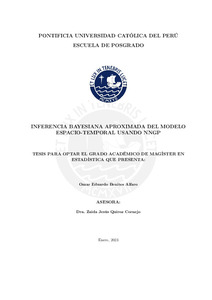| dc.contributor.advisor | Quiroz Cornejo, Zaida Jesús | |
| dc.contributor.author | Benites Alfaro, Omar Eduardo | |
| dc.date.accessioned | 2023-08-23T17:21:38Z | |
| dc.date.available | 2023-08-23T17:21:38Z | |
| dc.date.created | 2023 | |
| dc.date.issued | 2023-08-23 | |
| dc.identifier.uri | http://hdl.handle.net/20.500.12404/25759 | |
| dc.description.abstract | Los modelos espacio-temporales nos permiten estudiar la distribución espacial de una
variable en el tiempo. Por ejemplo, se puede estudiar la distribución espacial del material
particulado en un país a través de los años, dado que las concentraciones de material particulado
en estaciones cercanas pueden ser similares y la concentración en una estación en
un año puede depender de la concentración en la misma estación el año anterior anterior.
En esta tesis se propone usar un modelo espacio-temporal a través del proceso gaussiano de
vecinos más cercanos. Para implementar este modelo y aplicarlo en grandes bases de datos se
propone usar inferencia bayesiana a través del método de integración aproximada de Laplace
(INLA). La bondad de ajuste del modelo y su eficiencia se estudia a través de simulaciones.
Finalmente se aplica el modelo implementado a una base de datos reales. | es_ES |
| dc.description.abstract | Spatio-temporal models allow us to study the spatial distribution of a variable over time.
For example, we can study the spatial distribution of particulate matter in a country through
the years, given that the concentrations of particulate matter in nearby stations can be similar
and the concentration in a station in a year can depend on the concentration in the same
station in the previous year. In this thesis, we proposed to use a spatio-temporal model through
the nearest neighbor Gaussian process. In order to implement and apply the hierarchical
model in large databases, it is proposed to use Bayesian inference through Integrated nested
Laplace approximation(INLA). The goodness of fit and efficiency of the model is studied
through simulations. Finally, the model is applied to real data set. | es_ES |
| dc.language.iso | spa | es_ES |
| dc.publisher | Pontificia Universidad Católica del Perú | es_ES |
| dc.rights | info:eu-repo/semantics/openAccess | es_ES |
| dc.rights.uri | http://creativecommons.org/licenses/by/2.5/pe/ | * |
| dc.subject | Estadística bayesiana | es_ES |
| dc.subject | Geografía matemática | es_ES |
| dc.subject | Modelos matemáticos | es_ES |
| dc.title | Inferencia bayesiana aproximada del modelo espacio-temporal usando NNGP | es_ES |
| dc.type | info:eu-repo/semantics/masterThesis | es_ES |
| thesis.degree.name | Maestro en Estadística | es_ES |
| thesis.degree.level | Maestría | es_ES |
| thesis.degree.grantor | Pontificia Universidad Católica del Perú. Escuela de Posgrado. | es_ES |
| thesis.degree.discipline | Estadística | es_ES |
| renati.advisor.dni | 43704124 | |
| renati.advisor.orcid | https://orcid.org/0000-0003-3821-0815 | es_ES |
| renati.author.dni | 70429849 | |
| renati.discipline | 542037 | es_ES |
| renati.juror | Bayes Rodriguez, Cristian Luis | es_ES |
| renati.juror | Quiroz Cornejo, Zaida Jesus | es_ES |
| renati.juror | Valdivieso Serrano, Luis Hilmar | es_ES |
| renati.level | https://purl.org/pe-repo/renati/level#maestro | es_ES |
| renati.type | https://purl.org/pe-repo/renati/type#tesis | es_ES |
| dc.publisher.country | PE | es_ES |
| dc.subject.ocde | https://purl.org/pe-repo/ocde/ford#5.05.01 | es_ES |







